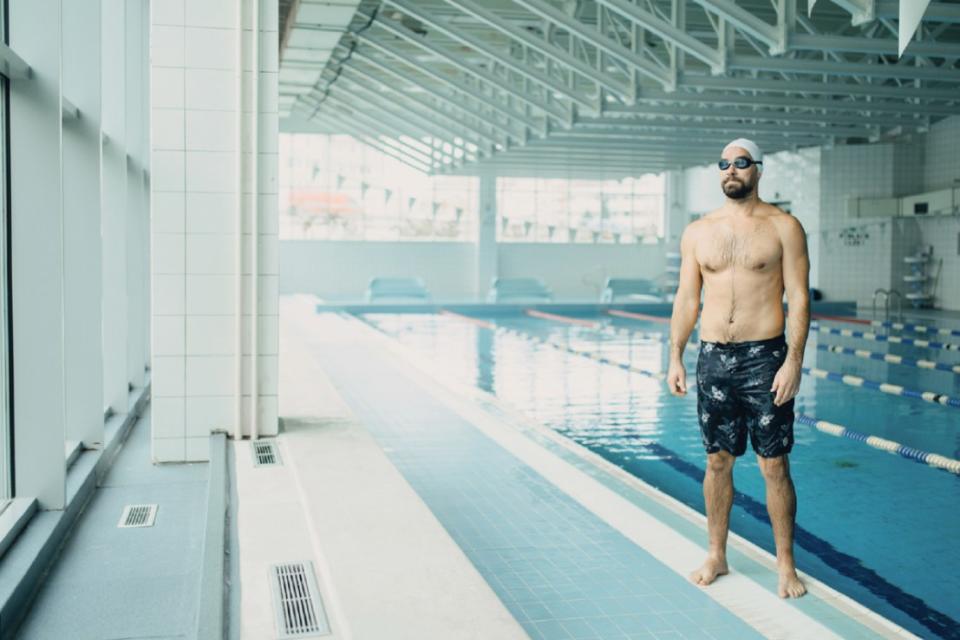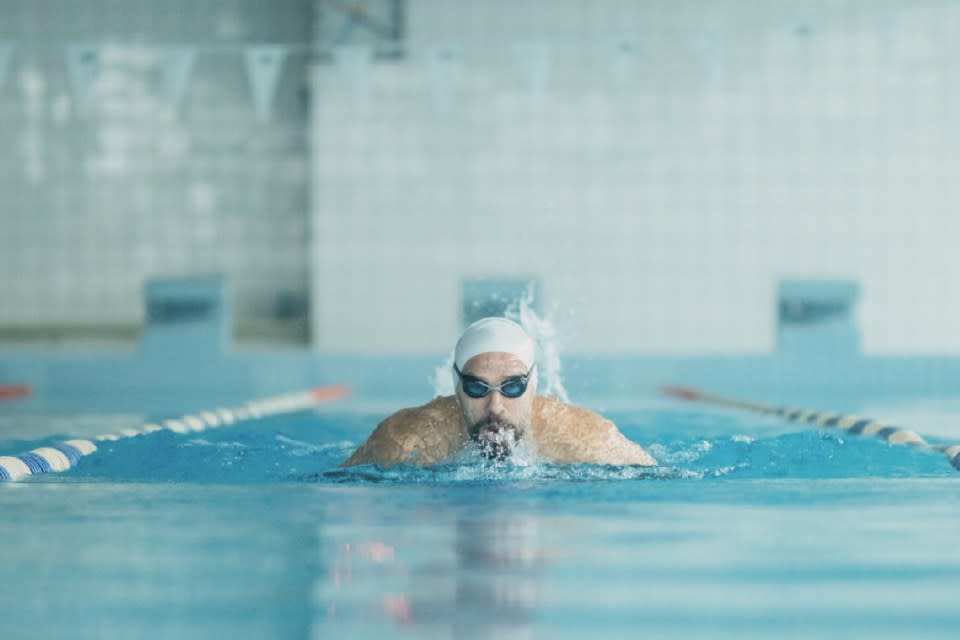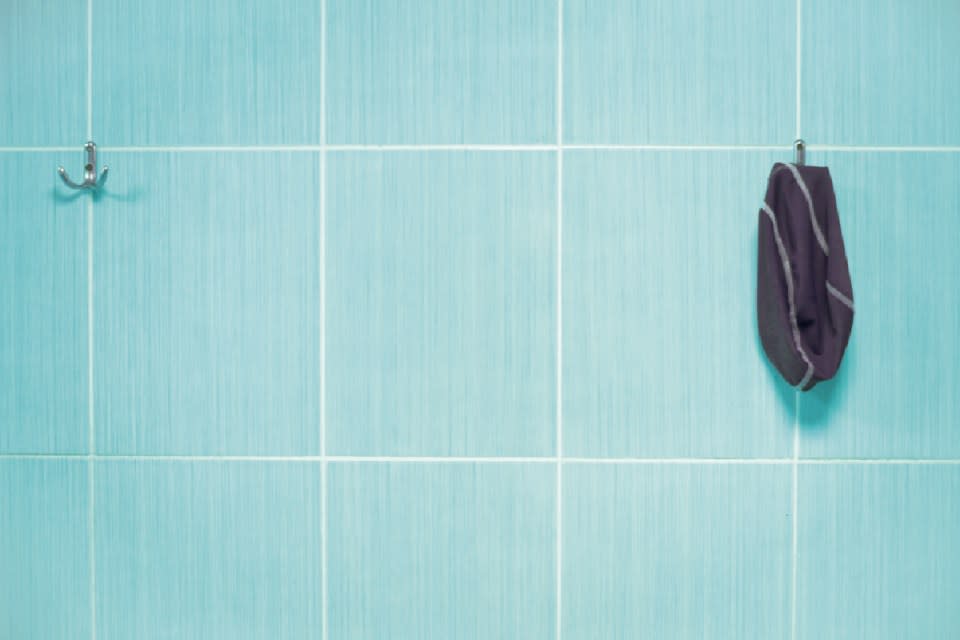Washed away: The strange, nostalgic world of public swimming pools

For more like this essay about swimming pools from City A.M. – The Magazine, tap here
In the swimming pool we can both forget who we are and dream of becoming someone else,” writes former competitive swimmer and author Piotr Florczyk in his short study, Swimming Pool. And indeed, when I ask myself why I used to slouch down to the municipal pool, towel trailing behind me, practically every day one summer it was – I feel – a way of washing myself away.
It all starts with the aggressively utilitarian building you walk into. You push through a turnstile, venture down slippery, grotty steps into a dingy room. Shoes off, you abandon your clothes, jewellery and other detritus. In a murky puddle of water masquerading as a footbath, you cleanse your feet. With your face obscured by cap and goggles, you leave the tiled hallway for the cavern of the pool.
We shuttle between two walls in a sunken pit filled with chemically-treated liquid, housed in a large, echoey building full of gymmers and swimmers, showers, tiles and mops
You plunge in and the water hits you. Cold chlorine rushes up your nose and water seeps in through the gaps around your goggles as you find yourself submerged. You squint and shiver. You come up desperate for air. Then, like Jesus parting the Red Sea, you separate the water that enfolds you with scooped hands. Using strokes you first learnt as a child, you strike through the water. When you reach the end, you flip over and continue shuttling between two walls in a sunken pit filled with chemically-treated liquid, housed in a large, echoey building full of gymmers and swimmers, showers, tiles and mops.
There is an intensity that’s integral to the act of lowering yourself into water and propelling yourself through it. If you don’t move, you’ll drown. Humans were not made to swim, so the very act is a rebellion against nature. We are not dolphins, nor sloths, who can apparently hold their breath for 40 minutes underwater.
•••

The swimming pool is defiantly uncool. Nowhere is this more true than in sunny southern France, where I lived for one infernally hot and oppressive summer. Here anyone who wants to display their beach body, flirt, get a tan or bask with any other libidinous intention could simply cruise on the tram down to the beach. The pool, by contrast, is for swimming. In France, nearly everyone in the pool had some sort of flotation device or flippers. This gave fully grown adults the appearance of not being able to swim in a manner I found curiously un-French.
For a place where we undress and parade around with bare legs and arms, the public swimming pool is remarkably unsexy and unsexualised. This is very much not the beach. Oldish, sometimes yellowing polyester (I’ll hold my hands up to this) prevails. It’s all Zoggs and Speedos (brands which, beguilingly, don’t even try to be cool). Perhaps this has something to do with what George Orwell described as the “naked democracy of the public swimming pool”.
In this regard, swimming is diametrically opposed to running, which has become an aspirational way to spend a weekend. This has been wholly unwelcome for veteran joggers like myself, who want no part in a fashion parade. But unless you’re charging down a hill in the middle of the Lake District, it’s hard to fully disconnect yourself from your surroundings.
Runners flaunt their gear: a branded cap, running belts, watches, socks, headphones, headbands, tights, laces, the newest neon carbon-plated shoes and heart-rate monitors. Brands are inextricably linked to running. Nike, Adidas, Saucony, New Balance, Hoka. Swimming is different. We wear our faded Zoggs costumes and ropey old goggles. A few people track their swims on Strava but it’s mercifully rare even for fitness fanatics. The resulting map (a generous description) is simply too dull. There just ain’t much glamour in chlorine and the echoes of screaming kids. I think that’s why pools are so endearing. We are laid bare, equalised in a way that rarely happens anywhere else.
•••

When I thought about going swimming for this article, I felt the same fear I used to feel each time I approached the French piscines. Perhaps you could call it the fear of exposure. Not only was I going to throw away the comforting consumerist individuality of my clothes, wipe my eyes of eyeliner and stuff my hair into a nondescript swimming cap (in France, they are mandatory), worse still I would be without my headphones (at the time, I was very into Hot Chip due to the influence of my cousin’s boyfriend). There would be no Huarache Lights or Over and Over to haze over my anxieties as they did for many of the other waking hours of my day. You have lost the soundtrack that distracts you from your life. In the pool, stripped of your identifying markers, you are forced to be alone with your thoughts.
What draws me to the pool is the thrill of belonging, momentarily, to a temporary world. When you’re in the water, it’s a secret club that exists for the hour or so you are there
With each length I thrashed out in the pool (I would swim for at least an hour each session), I erased the horror of my latest linguistic faux pas. I am doing the most boring thing possible, I would think, as I counted lengths, usually from one to 40 (another legacy from my father, who had happened upon this number due to its equivalence with one kilometre) but often to more than 100. Sometimes you stumble upon some semantic tangent that lasts enough lengths to dislodge the count from your head. After a time, the goggles cut into your flesh. You start to feel empty, which is strangely thrilling. For a while you glide, fly, slice, float, chop. Each stroke leaves you lighter.
What draws me to the pool is the thrill of belonging, momentarily, to a temporary world. When you’re in the water, it’s a secret club that exists for the hour or so you are there. Not unlike a London bus, the pool invites an extraordinarily wide variety of people. There are factions: you align with those in your lane and seethe at any poor etiquette displayed by new entrants. You become familiar with the speed and strokes of your comrades in aching arms.

For a while, I frequented Peckham Pulse, which has the benefit of being totally free for residents of Southwark every Friday and Sunday afternoon. Otherwise, swimming costs £5.65, which is within the realm of possibility for most Londoners. The highest strata of society will not be attending Peckham Pulse but everybody else does: children, exercise nuts, the employed and the unemployed, the fit and the unfit. There is a lane for you all (just don’t get in the wrong one).
At Hough End Leisure Centre, a modern affair with windows that stretch out onto Hough End Park in south Manchester, groups of men would visit just to chill, as if it were a Parisian coffee bar. They would lounge at the side for hours.
Balham Leisure Centre, meanwhile, is a particularly unpleasant building to spend time within – but that didn’t stop frequenters banding together; if anything it brought us closer. Older people and retirees and the unemployed tended to dominate during daytime hours.
I would enter, strip off in the changing rooms – avoiding the dirtiest parts of the floor in my bare feet – dump my stuff in a plastic tub and set it on the benches that line the side of the pool (there is a surprising amount of trust in this very un-London-like action). Then I would slip into the pool, normally in the fast lane due to my fellow swimmers being over 75.
It wasn’t hard to strike a rhythm with the others. Elderly posh-ish women floated past with impeccable posture, whereas I preferred to dunk myself in and out in a loose, intense interpretation of breaststroke. There was one particularly ghoulish-looking man with sunken eyes who, in my head, was known as The Corpse. The Corpse used to sporadically clamber out of the pool and dangle his frail, skinny, pale frame over the side until it cleared, then he would arch his body and dive, hurtling along the bottom of the pool for one entire length (25 metres). Inevitably, The Corpse emerged spluttering and sickly. I both hated and admired his expectation that an entire lane of co-swimmers would clear themselves for his little performance.
“Pushing off we can literally let go of things”, Florczyk writes. Perhaps that was what The Corpse was doing. Who knows from what? Thanks to the anonymity of the pool, I could never ask him.
•••

Nearly everyone has been to the swimming pool. Most attend lessons as school children. There are classes for babies, older people and people with disabilities. If you ask those around you for their recollections of pools, it is revealing. “The rapids at Centre Parcs!” one colleague grins with childlike glee. “The big float in the leisure centre on Saturday mornings!” “Swimming parties!” “Chocolate from the vending machine!” “The machine that dries your towel!”
I found these answers telling. Swimming as an adult is a monotonous grind. But the word ‘swimming’ tends to conjure up memories of fun-filled family days out. As adults, we insist on extracting the fun from every physical activity, bar sex and perhaps exotic romps like Zumba. Not so for children.
I asked my family for their most profound memories and reflections on swimming pools. “You, burning to a crisp, while a thousand wasps perished in a bowl of jam by your side,” my brother immediately replied. That’s not the sort of enchanting and ephemeral image I was looking for, I wrote back. Yet so often, for pale-skinned people, this is the reality (and another reason, you might think, to stick to indoor pools).
My dad pretended to be a basking shark named Barry who would eat us (in a kind way). This was the exciting new world opened up by the pool: the possibility to become someone else.
My father did most of his swimming in the large outdoor pool in the British High Commission in New Delhi, India, where I spent a significant amount of time between the ages of six and 10. It was a pool that had to be cooled due to the baking sun, full of children in colourful wetsuits (to avoid sunburn) and tanned or redding diplomats sweltering in a colonial compound.
I learned to do handstands, dive, hover at the bottom to let my sister use me as a surfboard, and would run around maniacally with three girls who looked and dressed identically to me, pretending to be quadruplets to anyone who would listen. My dad pretended to be a basking shark named Barry who would eat us (in a kind way). This was the exciting new world opened up by the pool: the possibility to become someone else.

In reality, the whole thing was an unforgivable luxury for mostly white-skinned diplomats in a country where 163m Indians lack access to safe drinking water.
That is the thing about pools. Despite the 1960s-built crumbling and moulding leisure centres of modern Britain being rather decrepit, they represent the extremes of affluence. It is, after all, very unnatural that we dig out 25m long pits, fill them with water and chemicals, then jump in and travel up and down them repeatedly. It is an unthinkable waste of resources, in many ways. The pool itself is a symbol of “control over the uncontrollable” writes Joan Didion, from southern California where “the apparent ease of life… is an illusion”.
•••

In Montpellier, southern France, there were lots of municipal piscines to choose from, and I tended to switch between two preferred options. One was the Olympic swimming pool – Piscine Olympique d’Antigone – flamboyantly named after the daughter of Oedipus and heroine of Sophocles’ tragedy. The other was a white-tiled basement pool called the Piscine Pitot which felt like discovering a secret each time you entered.
The Olympic pool, by dint of being Olympian sized, required a more Herculean strength to get through. In a bizarre and rather unchic twist of history, the Olympic pool is in a district of the city named Antigone. Due to the whim of 1970s mayor Georges Freche, each building, square and street name is inspired by the architecture of ancient Greece. This is enchanting in theory (ah, to stroll down Rue Poseidon…) until you’re faced with the reality. The anachronism isn’t subtle: grand columns, a horrid statue of Venus and a huge, curved, Soviet-sized municipal structure.
The Antigone pool itself had steps leading up to a nasty, blue-grey, translucent – yet also reflective – exterior that said ‘welcome to the dentist’ rather than ‘enjoy your swim’. Piscine Pitot, on the other hand, was a basement pool under a palatial and futuristic square with odd, white, metallic lattice structures in it.
Inside, the lighting was dim (why don’t they do this in England?) and if you went in the evening it played soft, ambient music. It was painfully tasteful. When you emerged you could see French kids fencing in the room next door. En garde! they cried, netted metal shielding their faces as they leaned forward to mock stab one another.
The only problem was the opening hours:
Monday: 12–2 pm
Tuesday: 12–2 pm, 5–8 pm
Wednesday: 11:30 am–4 pm
Thursday: 7:30–9 am, 12–2 pm
Saturday: 2–6 pm
Sunday: 9 am–1 pm
They remain so to this day. The questions of who wrote this timetable, what on earth they were fitting it around and how the pool made any money (entry was two euros, even in 2023) all go unanswered.
•••

Despite the undeniable allure of the swimming pools, fewer and fewer people are choosing it as their pastime. Between 2010 and 2023, 400 pools closed in England (not just due to lack of funding, given many leisure centres are privately owned), which is a terrifying prospect for the nation’s young swimmers.
There has, mercifully, been some backlash to this decline. A splash of hope was the campaign to save Withington Baths in south Manchester. A detailed Edwardian red brick building with a conservatory roof, Withington Baths first opened its doors in 1913. Its architecture, stained-glass windows and period tiles drench it in charm and elegance, words that will never be used to describe the likes of Peckham Pulse or Deptford Wavelengths.
The swimming pool is, paradoxically, a place of both solitude and community. It’s a strange human ritual practised in Manchester, Montpellier, New Delhi and every other town across the world
In 2014 the council proposed shutting it, along with two other pools, to save £80m from its budget. Locals fought back. Love Withington Baths mounted a two-year campaign that saved the pool from closure. Having lived in Withington, I can say with certainty that the baths really were a cornerstone of the community.
But Withington is simply a shining example of a universal truth. The swimming pool is, paradoxically, a place of both solitude and community. It’s a strange human ritual practised in Manchester, Montpellier, New Delhi and every other town across the world. Most cities have a cluster of swimmers who find some solace in the churn of repeated strokes. Together, but alone. Not you, but another version of you. The pool is a place of possibility.


 Yahoo Finance
Yahoo Finance 